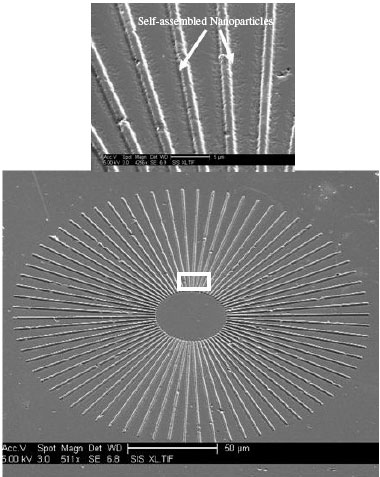| Posted: Aug 01, 2006 | |
Self-assembly of nanoparticles - a step towards realizing completely self-organized devices |
|
| (Nanowerk Spotlight) The fabrication of ultrafine structures beyond the limits of conventional lithography is a topic of tremendous importance and is expected to play a significant role in the realization of futuristic nanotechnology. It is also equally important to develop functional material systems of ultrafine dimensions in order to achieve this goal. An important step towards realization of nanodevices is self-organized nanopatterning of functional structures. A new technique, which might be called ‘chemical lithography’, enables the regular assembly of optically active nanoparticles on a silicon surface. | |
| An international group of researchers report the fabrication of ultrafine luminescent structures through nanoparticle self-assembly. They report their findings in the July 6, 2006 online edition of Nanotechnology. | |
| "In order to effectively utilize the nanostructures as functional elements in nano devices, absolute controllability of their properties, such as the size, shape and spatial distribution, is essential" Kuniyil Prabhakaran, first author of the paper, explains to Nanowerk. The problems associated with the growth of materials to fabricate periodic arrays of quantum dots can be overcome by substituting nanoparticles for quantum dots. | |
| In their approach, the researchers utilize a spatially controlled difference in reactivity for the formation of periodic arrays of nanoemitters. The silicon surface is prepared in such a way that regions with different reactivities are spatially separated and therefore can be selectively transformed through suitable treatments. Nanoparticles of EU3+-doped YAG (yttrium aluminum garnet, a mixed ceramic oxide ) self-assembled on this patterned silicon substrate. These particles emit photons in the visible spectrum at room temperature when excited by a laser. The emission from these nanoparticles is stable and does not undergo any photobleaching effects. | |
| "If we can attach the desired nanoparticle (exhibiting the desired property) onto desired locations of the wafer, it can lead to nanoarchitecturing and can have profound impact in the field of nanotechnology" says Prabhakaran. "As the nanostructures do not function as devices by themselves, it is important to transform them into functional elements. Further, the fact that these fine structures have to be preserved intact, underlines the need to develop a more natural or self-organized process to functionalize them. In order to achieve this, we have to understand the behavior of the atoms and molecules at a more fundamental level so that we can "force" self-organization." | |
 |
SEM image from a radial pattern fabricated on a silicon wafer, where the Eu:YAG NPs are self-assembled along the edges of the pattern. The inset shows a closer view. The arrows indicate regions where the particles are selectively self-assembled. (Reprinted with permission from IOP Publishing) |
| Prabhakaran points out that "in our research, we have been addressing these issues by examining the surface properties and reactivities of silicon based systems. We have also developed novel techniques to synthesize a variety of functional and multifunctional nanoparticles with well defined shapes and properties." | |
| It is therefore possible to assemble particles emitting light at more than one wavelength, magnetically active particles and design nanoarchitectures to achieve what may be called a "system on a chip". | |
| "We believe that our approach can be universal and extendable to more specific functionalities, such as particles emitting at a particular wavelength or some specific magnetic properties" says Prabhakaran. "This method has the potential to deliver tailored functional nanoarchitectures. Such a bottom-up approach will play a major role in realizing completely self-assembled nanodevices." | |
 By
Michael
Berger
– Michael is author of three books by the Royal Society of Chemistry:
Nano-Society: Pushing the Boundaries of Technology,
Nanotechnology: The Future is Tiny, and
Nanoengineering: The Skills and Tools Making Technology Invisible
Copyright ©
Nanowerk LLC
By
Michael
Berger
– Michael is author of three books by the Royal Society of Chemistry:
Nano-Society: Pushing the Boundaries of Technology,
Nanotechnology: The Future is Tiny, and
Nanoengineering: The Skills and Tools Making Technology Invisible
Copyright ©
Nanowerk LLC
|
Become a Spotlight guest author! Join our large and growing group of guest contributors. Have you just published a scientific paper or have other exciting developments to share with the nanotechnology community? Here is how to publish on nanowerk.com.
